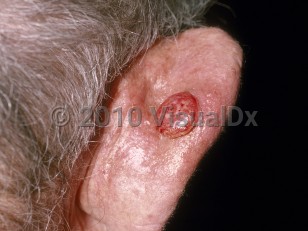Cutaneous squamous cell carcinoma - Nail and Distal Digit
See also in: Overview,Anogenital,Hair and ScalpAlerts and Notices
Important News & Links
Synopsis

Predisposing factors include trauma, immune suppression, human papillomavirus (type 16), smoking, chronic bacterial or viral infection, tar, arsenic, chronic radiation exposure, radiation therapy, or inherited dermatologic disorders such as ectodermal dysplasia, dyskeratosis congenita, or dystrophic epidermolysis bullosa. TP53 mutations have been found in SCC of the nail bed.
SCC of the distal digit typically begins in the lateral nail fold or distal groove and invades the nail unit by extension; nevertheless, SCC may occasionally arise in the nail bed. The early appearance may mimic that of more benign conditions such as verruca, chronic paronychia, or infection.
A diagnostic biopsy is often delayed due to the slow progression of disease, patient reluctance to undergo biopsy, technical difficulties, or prolonged treatment of a suspected benign condition. The histology is typically well-differentiated and may appear entirely in situ (Bowen disease). However, as long-standing Bowen disease frequently shows evidence of microinvasion on serial histologic cuts, it is typically treated as aggressively as invasive SCC.
Nail SCC generally has favorable metastatic rates and mortality when compared to nail melanoma. Nail SCC rarely metastasizes, and when it does, it is more common in poorly differentiated tumors and immunosuppressed patients. Neglected lesions may spread contiguously to the adjacent bone.
Codes
C44.92 – Squamous cell carcinoma of skin, unspecified
SNOMEDCT:
402815007 – Squamous cell carcinoma
Look For
Subscription Required
Diagnostic Pearls
Subscription Required
Differential Diagnosis & Pitfalls

Subscription Required
Best Tests
Subscription Required
Management Pearls
Subscription Required
Therapy
Subscription Required
Drug Reaction Data
Subscription Required
References
Subscription Required
Last Updated:04/06/2023
 Patient Information for Cutaneous squamous cell carcinoma - Nail and Distal Digit
Patient Information for Cutaneous squamous cell carcinoma - Nail and Distal Digit- Improve treatment compliance
- Reduce after-hours questions
- Increase patient engagement and satisfaction
- Written in clear, easy-to-understand language. No confusing jargon.
- Available in English and Spanish
- Print out or email directly to your patient



